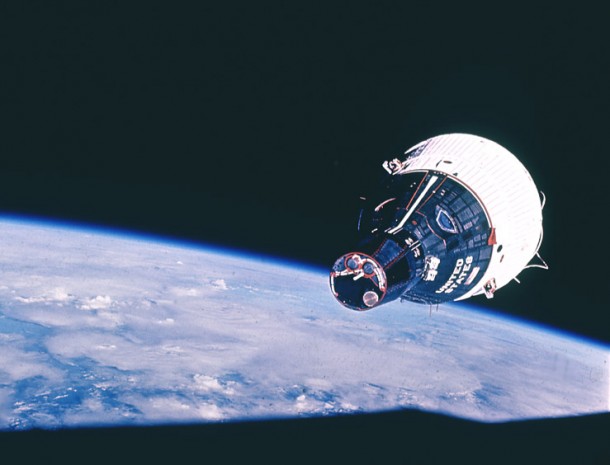
Forty-eight years ago this month, Gemini 7 set a new record for long-duration manned spaceflight. The official lift-off-to-splashdown flight duration was 330 hours, 35 minutes and 1 second.
Project Gemini was the critical bridge between America’s fledgling manned spaceflight effort – Project Mercury – and the bold push to land men on the Moon – Project Apollo. While the events and importance of this program have faded somewhat with the passage of time, there would have been no manned lunar landing in the decade of the 1960′s without Project Gemini.
On Thursday, 25 May 1961, President John F. Kennedy addressed a special session of the U.S. Congress on the topic of ”Urgent National Needs”. Near the end of his prepared remarks, President Kennedy proposed that the United States “should commit itself to achieving the goal, before this decade is out, of landing a man on the moon and returning him safely to the earth.”
At the time of the President’s clarion call to go to the Moon, the United States had accrued a total of 15 minutes of manned spaceflight experience. That quarter hour of space faring activity had come just 20 days previous. Indeed, Alan B. Shepard became the first American to be launched into space when he rode his Freedom 7 Mercury spacecraft on a sub-orbital trajectory down the Eastern Test Range on Tuesday, 05 May 1961.
America responded enthusiastically to the manned lunar landing goal. However, no one really knew exactly how to go about it! After considering several versions of direct ascent from the Earth to the Moon, NASA ultimately decided to use a method proposed by engineer John C. Houbolt known as Lunar Orbit Rendezvous (LOR). As a result, NASA would have to invent and master the techniques of orbital rendezvous.
Project Gemini provided the technology and flight experience required for a manned lunar landing and return. In the 20 months between March of 1965 and November of 1966, a total of 10 two-man Gemini missions were flown. During that time, the United States learned to navigate, rendezvous and dock in space, fly for long durations and perform extra-vehicular activities.
The primary purpose of Gemini 7 was to conduct a 14-day orbital mission. This was important since the longest anticipated Apollo mission to the Moon and back would be about the same length of time. Gemini 7 was flown to show that men and spacecraft could indeed function in space for the required period. A secondary goal of Gemini 7 was to serve as the target for Gemini 6 in achieving the world’s first rendezvous between two manned spacecraft.
Gemini-Titan (GT-7) lifted-off from Cape Canaveral’s LC-19 at 19:30:03 UTC on Saturday, 04 December 1965. The Gemini 7 flight crew consisted of Commander Frank F. Borman II and Pilot James A. Lovell, Jr. They were successfully inserted into a 177-nm x 87-nm low-earth orbit. This initial orbit was later circularized to 162-nm.
Borman and Lovell spent the first 10-days of their mission conducting a variety of space experiments. They wore special lightweight spacesuits that were supposed to improve comfort level for their long stay in space. However, these suits were not all that comfortable and by their second week in space, the astronauts were flying in just their long-johns.
On their 11th day in space, the Gemini 7 crew had visitors. Indeed, Gemini 6 was launched into Earth orbit from Cape Canaveral and subsequently executed the first rendezvous in space with Gemini 7 on Wednesday, 15 December 1965. Gemini 6, with Commander Walter M. Schirra, Jr. and Pilot Thomas P. Stafford on board, ultimately maneuvered to within 1 foot of the Gemini 7 spacecraft.
While Gemini 6 returned to Earth within 24 hours of launch, Gemini 7 and her weary crew soldiered on. The monotony was brutal. Borman and Lovell had conducted all of their planned space experiments. They had to drift through space to conserve fuel. They couldn’t sleep because they weren’t tired. Borman later indicated that those last 3 days on board Gemini 7 were some of the toughest of his life.
On the 14th day of flight, Saturday, 18 December 1965, Borman and Lovell successfully returned to Earth. Reentry was entirely nominal. Splashdown occurred at 14:05:04 UTC in the Atlantic Ocean roughly 400 miles east of Nassau in The Bahamas. Crew and spacecraft were recovered by the USS Wasp.
Frank Borman and Jim Lovell had orbited the Earth 206 times during their 14-day mission. Each crew member was tired and a little unsteady as he walked the flight deck of the USS Wasp. However, each man quickly recovered his native strength and vitality.
The 14 days that the Gemini 7 crew spent in space were physically and emotionally demanding. Life within the cramped confines of their little spacecraft was akin to two guys living inside a telephone booth for two weeks. Notwithstanding the challenges of that spartan existence, the Gemini 7 crew did their job. Gemini 7 was a resounding success. More, Project Gemini had achieved another key milestone. The Moon seemed a bit closer.

Comments
Using the Gemini spacecraft for a manned Lunar landing was considered as early as the original Mercury Mark II proposal which led to the Gemini program.
Share this post: